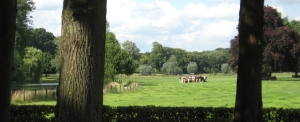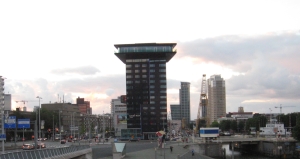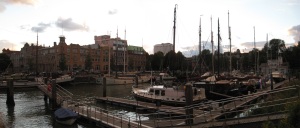Rem Koolhaas once described the urban as pervasive. It took a tour of Holland for me to grasp quite what he meant. While Paris is mocked as a museum-city due to its protected urban tissue, in Holland it is the farmland that is protected, the rural tissue that cannot be modernized. This makes the experience of moving in the country, which is about the same size as the Dallas-Fort-Worth metropolis and has more people, utterly surreal.
Holland today is called the Randstad, or the Edge City, since its four biggest cities, Amsterdam, The Hague, Rotterdam and Utrecht, were joined together by highways, leaving the heart of the country as the farmland the Dutch had created it to be. (God may have made the Earth but the Dutch made the Netherlands, so the saying goes.) With less than an hour travel time from any city to another making connections perfectly simple, the urbanization of the cities into one large metropolis was inevitable, just as the urbanization of the land between them was inevitable.
While, traveling from one city to the next, one may see a landscape of grazing fields for dairy cows, this landscape is always seen from a road that is packed with other travelers. Wherever you go, the ubiquitous presence of other people can be felt, either by running into them on their bicycles or just as the background noise of a not-far-enough highway. The grazing land and windmills may be beautiful to look at, they are only a decor, and the presence of other people, as well as the occasional 6-story office building squeezed in between two herds of cows, serve to remind you at every step how unnatural this arrangement is.

Typical Dutch landscape, but imagine the noise of an urban highway in the background for the real picture
Urbanity is, ultimately, nothing more than people circulating. We sense that a place is urban where there are crowds (or in the controversial words of Rem Koolhaas, congestion). And good urbanism, in that sense, is taking full advantage of the crowd, with the small things like street-side cafes for people watching, the less small things like tramways, and the dramatically monumental things like balconies over a railway station concourse. Bad urbanism, on the other hand, is hiding the crowd away, or pretending that it isn't there. This is what the land use policy of the Netherlands does.
Why do the Dutch need this farmland anymore? According to Dutch government statistics, land becomes at least twice as valuable once the land is rezoned as "urban". That implies that making cheese is not nearly as important to people as human residence, industry and business. The government maintains that the zoning is necessary to protect the country against the market failure of not providing a beautiful landscape.
The landscape of Holland is the most artificial of any place in the world. Everything in the country was made by human hand. It all came out looking quite natural. Christopher Alexander even used the historic center of Amsterdam as an example of a city grown naturally in A New Theory of Urban Design. It is genuinely beautiful. Have the Dutch lost confidence in their own hands? What is going on?
If you follow architecture at all, you will be aware that Holland is considered as something like the Shangri-La of Modernism, a country where the modern paradigm has been fully embraced and where architectural experimentation is the rule. The result of this experimentation has been hard modernist mega-estates like Biljmermeer (it's bigger than Sarcelles! exclaimed our companion) in the outskirts of Amsterdam, a city that despite having been reinvested with new modernist buildings, still is a ghost town compared to the bustle of Amsterdam, to the fashionably impractical like the diamondoid houses of Rotterdam, and terminating in the plain grotesque like the foodstrip that greets you on the highway into Amsterdam. What emanates from this experimentation is that the lessons acquired from one experiment are never used in the next, defeating the whole purpose of an experiment. We can only conclude that what is taking place cannot be defined as experimentation. The precise term for modernism is folly.
Against an onslaught of follies mutilating their landscape, what could the Dutch do but turn hyper-conservative in horror? They must realize though that the lines drawn on zoning maps can only be a temporary measure, a rear-guard action while waiting for the day we are no longer confused about what we are. I can imagine a Randstad with a center of parks, houses and estates that would be just as beautiful and natural as the current landscape and also serve as relevant solutions to the current problems of Dutch life. We don't need to zone out the present. We don't have to be afraid of ourselves anymore. We just need to know how to make things like nature does. Then the landscape that we have always made will once again be natural.
While Paris may be a monument to an urban past, the late 19th century, that no longer exists, the Randstad is a monument to a rural past that has long vanished. It is a museum-country that functions as a modern city. A tour of Holland is the essential companion to Rem Koolhaas' S,M,L,XL, which is the essential narrative of late 20th century architecture and urbanism. If you ever wondered what could have produced such a strange mind, Holland could.
P.S. What was originally meant to be a weekend trip to Amsterdam with three fellow students of the Institut d'Urbanisme over the long July 14 weekend turned into, due to last minute planning, a full tour of Holland, with stops in Utrecht, Rotterdam and Amsterdam, and lightning visits to towns like Bunnik, Gouda, The Hague and Shoeveningen, the Biljmermeer suburb of Amsterdam and Gorinchem. That is to say, we did a full tour of the Randstad. Since it was on the way, we also stopped in Ghent and Antwerp, which felt somewhat more normal than Holland. The reason for this, I concluded recently, was that there were far fewer people on the roads.
P.P.S. Do not remain illegally parked in Amsterdam's historic center, particularly not if your driver is an irritable parisian. Parking enforcement is very serious business there, with visibly positive consequences on the quality of the city.







Comments
I'm a bit mystified by this post. You seem to be implying that food production, in close proximity to urban centres, is somehow anachronistic. Or that the traditional landscape of Holland is not worthwhile preserving either for the food it produces, the aesthetic appeal it affords, and the sense of visual relief it provides in an environment that due to its unrelenting flatness, can feel clautrophobic. If long range food supply chains are ultimately ruptured due to future energy scarcity, the green heart of Holland may be considered less as an act of cultural nostalgia, but rather a wise application of the precautionary principle. In the meantime, it provides one of the singular pleasures of the Netherlands: the ability to have the intensely urban immediately juxtaposed to the pleasantly rural.
The traditional landscape of Holland is as much its cities as it is the farmland. It has not been preserved. The Dutch are no longer making traditional cities. It is important to know the difference between preservation and protection. The preservation of a culture is the renewed practice of it, and that means building more cities in the traditional process to keep it alive. Because that is now zoned out the landscape is not being preserved, merely protected from change. That means change in the food being consumed, which means fewer cows today than yesterday, but perhaps more cows in the future. Who knows? If that becomes necessary, the landscape can revert to farming, but the process of change should not be stopped. A zoned landscape is never going to feel natural.